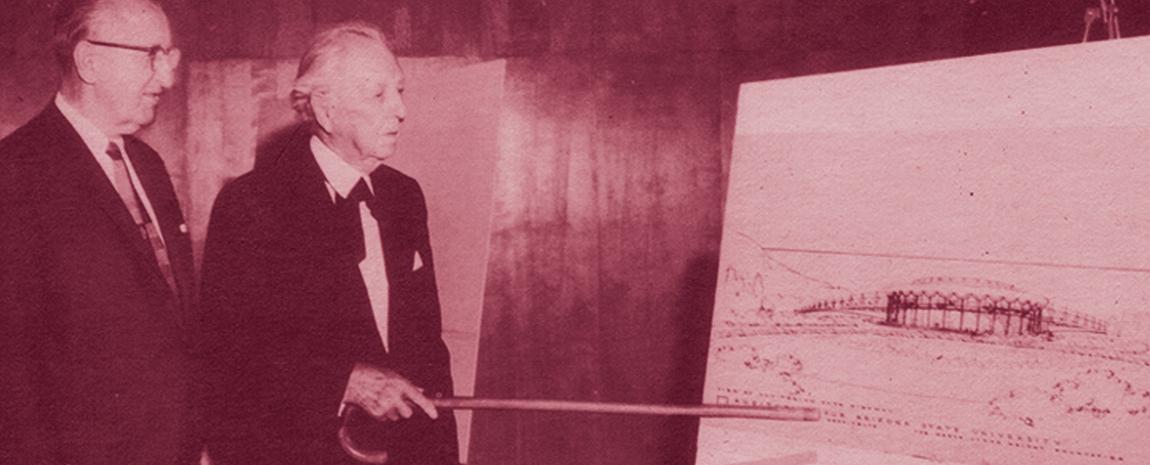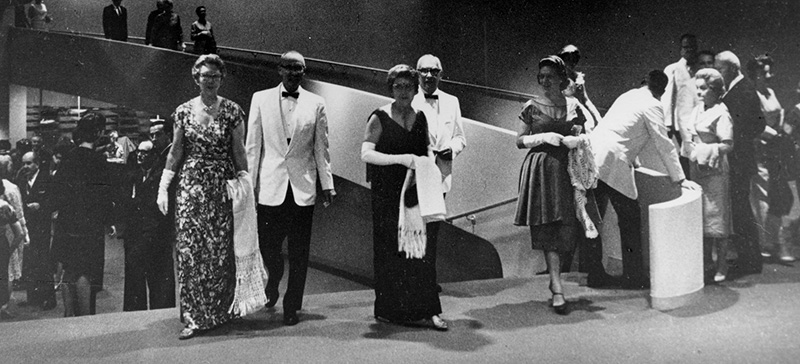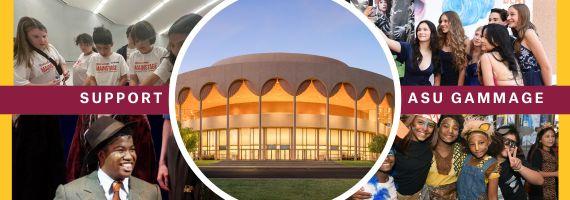
History
ASU Gammage from the beginning
In 1957, ASU past President Grady Gammage had a vision to create a distinct university auditorium on the campus of Arizona State University (ASU). He called on close friend and famed architect Frank Lloyd Wright to assist with the project. As luck would have, Wright had a design prepared for an opera house in Baghdad, Iraq that did not come to fruition that he decided to use for this theater.
During a tour of the campus, Wright took a liking to an athletic field and said, "I believe this is the site. The structure should be circular in design and yes, with outstretched arms, saying 'Welcome to ASU!'" Wright worked on the sketches for the building during the last two years of his life. His most trusted aide, William Welsey Peters, brought his plans to finished form.

Neither Wright nor Gammage lived to see the transformation of the blueprints, but their vision instantly became an iconic venue under the new direction of R.E. McKee Company from El Paso, Texas to complete the construction. In 1962, Grady Gammage, Jr. turned the first shovel of dirt in the official groundbreaking.
Construction of the $2.46 million building took 25 months. ASU Gammage stands 80 feet high, eight stories by normal building standards, and measures 300 by 250 feet. Two pedestrian bridges add to the feeling of vastness, and extend 200 feet like welcoming arms. ASU Gammage was completed in September 1964. ASU Gammage is the only public building in Arizona designed by Wright.
The 3,000-seat performance hall offers three levels of seating, with the furthest seat only 115 feet from the stage. The acoustics are well balanced for unamplified performance, and the floating design of the grand tier assures an even flow of sound to every seat.
The stage can be adapted for grand opera, musical and dramatic productions or for symphony concerts, organ recitals, chamber music recitals, solo performances and lectures. The remarkable versatility of the stage is enhanced by a collapsible orchestra shell which, when fully extended, can accommodate a full orchestra, chorus and pipe organ. The shell is telescoped into a specially designed storage area when not in use.

ASU Gammage celebrated its grand opening with great fanfare on September 18, 1964. Under the baton of legendary conductor Eugene Ormandy, The Philadelphia Orchestra filled the hall with a history making first performance. The first Broadway production was in 1964 and was Camelot. For the next 30 years, ASU Gammage was host to many national and international dance companies including Alvin Alley Dance Company, Boston Ballet, Martha Graham Dance Company, Joffrey Ballet and Broadway productions as well as legendary musicians including B.B. King, Neil Diamond, Bruce Springsteen, Johnny Cash and Elton John.
Since it opened, ASU Gammage has had five executive directors, David Scoular 1964-74, Warren Sumners, 1974-79, Miriam Boegel 1979-84, Jim O'Connell 1984-91 and Colleen Jennings-Roggensack has served since 1992. Jennings-Roggensack has artistic, fiscal and administrative responsibility for ASU Gammage, ASU Kerr Cultural Center, with additional responsibility for non-athletic activities at Sun Devil Stadium and Wells Fargo Arena.
In 1992, Colleen Jennings-Roggensack took the helm as executive director and established the mission of Connecting CommunitiesTM. The organizational mission of Connecting CommunitiesTM allows ASU Gammage to go beyond its doors to change lives for the better and make a difference in our community through the shared experience of the arts. Through this initiative, ASU Gammage has discovered and created new avenues of communication through the arts to bridge cultural, economic and geographic divides. Along with its mission, Cultural Participation programs have been created that take artists’ work into classrooms and community organizations so that patrons of all ages and backgrounds can reap the benefits of arts involvement. For young people in particular, those benefits can be profound. Studies have shown that students who are involved in the arts perform better academically, are more involved in community affairs, have higher self-esteem and better attitudes toward school, and are less likely to drop out.
In Arizona, more than 134,000 students attend a school without any access to arts instruction and ASU Gammage provides numerous programs that give K-12 and university students opportunities to experience the arts through artist residencies, teacher development workshops and curriculum based programs that meet state arts education standards. Through a long-standing partnership with the Kennedy Center, ASU Gammage brings artist-mentors to Valley schools to work with teachers on integrating visual arts, dance, drama and music into mathematics, social studies, language arts and science lessons. By integrating the arts into other core subjects, teachers increase student engagement and make learning more relevant and meaningful.
Experiencing art communally with others also creates and strengthens social bonds, leading to an increased feeling of trust, mutual understanding and shared values that are vital for a healthy community. Exposure to the arts can even convey health benefits for people of all ages.
In the last 20 years, Jennings-Roggensack has commissioned 22 works to premiere at ASU Gammage which is more than any other presenter in the Southwest. Commissioned artists include Philip Glass, Trisha Brown, Bill T. Jones and the first North American commission of Pina Bausch.
Roggensack has also grown ASU Gammage into the largest university-based presenter of performing arts in the world. The Desert Financial Broadway Across America – Arizona series generates significant dollars, beyond the box office. The series is a leading economic engine for Tempe as well as the rest of the Valley. Even during difficult economic times, the series brought in nearly a billion dollars in economic impact to the Valley in the past 20 years. Since 1992, its estimated that ASU Gammage through its Broadway series brought in nearly $1 Billion of economic impact to Tempe as well as the rest of the Valley.
Since 1991, hundreds of well-known celebrities, musicians and performers have come through the theater as well including Mary J. Blige, Billy Crystal, Tony Bennett and Melissa Etheridge. Past artists include icons of dance, Mikhail Baryshnikov, Rudolph Nureyev, Bill T. Jones and the Bolshoi Ballet and pillars of classical music, Vladimir Horowitz, Phillip Glass, Yo Yo Ma and Itzhak Perlman. ASU Gammage also hosted the 2004 presidential debate, lectures, and symposiums featuring the world’s most prominent scientists, authors, dignitaries, politicians, and scholars, including Stephen Hawking, Elie Wiesel, Maya Angelou and Margaret Thatcher. ASU Gammage is also one of the major presenters of Touring Broadway and has presented significant productions including THE PHANTOM OF THE OPERA, WICKED, THE LION KING, MISS SAIGON, LES MISERABLES, ANGELS IN AMERICA, AUGUST: OSAGE COUNTY, JERSEY BOYS and many more.









